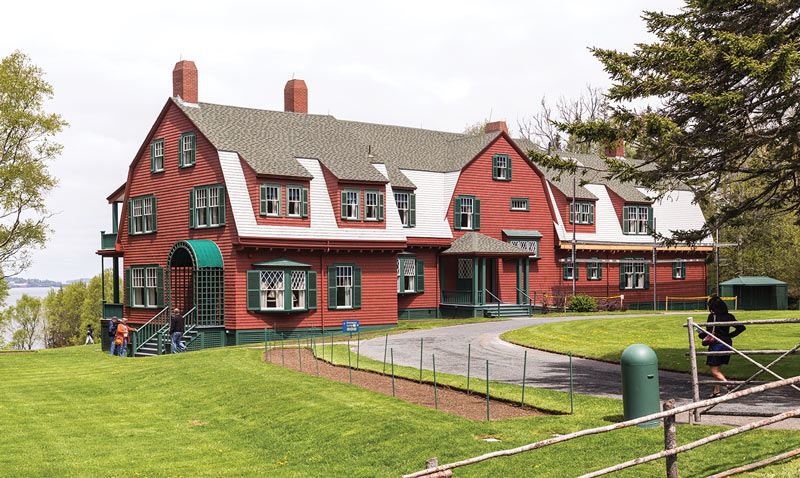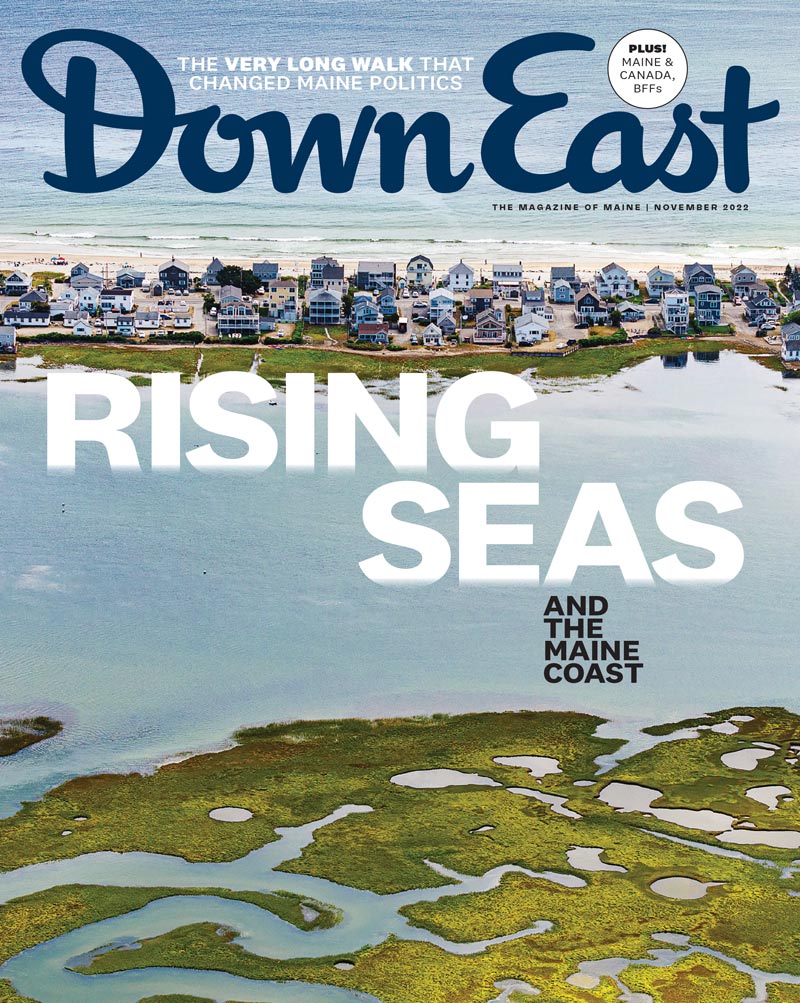By Joyce Kryszak
From our November 2022 issue
It would be about a three-minute drive from downtown Lubec to Campobello Island, just across the Franklin Delano Roosevelt Memorial Bridge, over the narrow channel between the U.S. and Canada. It would be, except for the stop at border control, which is usually uneventful, but not always. “Yeah, it’s squirrely with the borders,” Nick Newman said when I showed up a few minutes late at Roosevelt Campobello International Park, after Canadian border agents had given my passport what seemed like a longer-than-usual inspection. “We kind of get used to it over here — I mean we have to, right?”
A 44-year-old Campobello native, Newman works as an arborist at the park, where Franklin and Eleanor Roosevelt used to summer. “I love it here,” he says, “but Campobello doesn’t have what we need.” He had agreed to meet up to talk about just that — the peculiar limbo in which Campobello’s 872 year-round residents exist. The nearest gas station, bank, full-service grocery, and hardware store are all in Lubec. The nearest hospital is 45 minutes away, in Machias. The Canadian mainland is only accessible via two connecting ferries (that run infrequently in the winter) or by crossing the border at Lubec, driving an hour to Calais, and re-crossing at St. Stephen.
When international travel was shut down due the pandemic, Campobello residents could still cross the border for essential needs. And many islanders hold dual citizenship — Americans naturalized as Canadians or vice versa, owing to intermarriages or to living on one side or the other for an extended while. Newman is one of them. In his case, his mother is from Maine, and she had him naturalized as an American when he was a teenager. As we chatted near the Roosevelts’ old estate, park supervisor Jon Southern happened by and recounted the time U.S. border agents, for unstated reasons, searched his car and removed all the seats. Then, he says, “They handed me a wrench, saying, ‘Good luck.’”
Scenes from Campobello. Photos by Mike O’Leary.
After a while, Neman mentioned he needed to pop over to Lubec to get gas and pick up a pizza for dinner. I hopped into his Ford F-150, and he steered us back toward the border. Even as a dual citizen, Newman sometimes has trouble, recalling a time early in the pandemic lockdown when a U.S. border agent turned him back because his father, who doesn’t have U.S. citizenship, was riding along. “I’ve lived here my whole life. They all know me. Both my kids were born in Machias. I was just going to buy hay for my cows!” The agent told him the trip wasn’t essential for his father. His cheeks flushed a little at the memory. “It got pretty heated alright,” he said. When an agent asked for our passports this time, Newman had forgotten his. He presented his driver’s license, and we were waved through anyway.
A couple of minutes later, at McFadden’s Variety, Newman chatted with a Lubec friend while pumping gas, then joked with the clerk about the lopsided exchange rate.
“That’ll be $350 Canadian, right?” he asked.
“Yup, pretty much,” she laughed.
Newman introduced me to the owner’s brother, Mike McFadden, an American who married a Campobello woman. They bought a house on the island, but he got so tired of navigating the border that, one day, they just up and left their house, crossed to Lubec, and stayed.
Driving back to Campobello, I was a little worried because I hadn’t updated my ArriveCAN, the app-based form Canadian customs wants travelers to fill out in advance. Newman smiled when I asked if he thought it would be a problem. “Well, we’re gonna find out here in a second,” he said.
Decamp to Campobello
A short guide to visiting small but mighty Roosevelt Campobello International Park.

Play
The 2,600-acre island park, just across the border from Lubec, is managed by both the U.S. and Canadian park services. And though it’s one-twentieth the size of Acadia National Park, what it lacks in size it more than makes up for in presidential history, big natural scenery, and small crowds. The Roosevelt Cottage (“cottage”) is a 34-room seaside mansion where, in 1921, FDR came down with polio. The home later served as his summer White House, and visitors can tour the president’s office, the first lady’s writing room, and more. The most striking stretch of the park’s 8-mile trail network is the fairly easy section between Liberty Point and Raccoon Beach — dramatic cliffs, balsam-scented trails, and endless ocean views. No entrance fees. The Roosevelt Cottage is open late May–early October. Natural areas are open year-round.
Stay
On the island, Friars Bay Inn & Cottages offers well-kept, no-frills waterfront accommodations, with or without kitchenettes, and guests can stroll along the beach to the Roosevelt Cottage. For a waterfront perch in Lubec, check out the similarly unfussy Inn on the Wharf, with traditional rooms, along with apartment-style options, some of which are housed in a former sardine cannery.
Eat
The park-run Prince Café is next door to the old Roosevelt place, in another historic “cottage,” and serves coffee, baked goods, and breakfast and lunch — grab a spot on the porch for grand views of Passamaquoddy Bay. On Lubec’s main drag, Cohill’s Inn and the Water Street Inn both dish up chefy bites in pubby settings. And while most local businesses are seasonal, Lubec Brewing Company (207-733-4555) makes first-rate pizzas and keeps limited weekend hours through the off-season.






